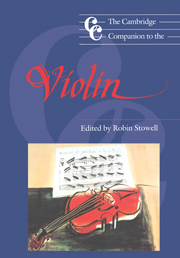Book contents
- Frontmatter
- 1 The violin and bow – origins and development
- 2 The physics of the violin
- 3 The violinists of the Baroque and Classical periods
- 4 The nineteenth-century bravura tradition
- 5 The twentieth century
- 6 The fundamentals of violin playing and teaching
- 7 Technique and performing practice
- 8 Aspects of contemporary technique (with comments about Cage, Feldman, Scelsi and Babbitt)
- 9 The concerto
- 10 The sonata
- 11 Other solo repertory
- 12 The violin as ensemble instrument
- 13 The pedagogical literature
- 14 The violin – instrument of four continents
- 15 The violin in jazz
- Appendix Principal violin treatises
- Glossary of technical terms
- Notes
- Select bibliography
- Index
10 - The sonata
Published online by Cambridge University Press: 28 September 2011
- Frontmatter
- 1 The violin and bow – origins and development
- 2 The physics of the violin
- 3 The violinists of the Baroque and Classical periods
- 4 The nineteenth-century bravura tradition
- 5 The twentieth century
- 6 The fundamentals of violin playing and teaching
- 7 Technique and performing practice
- 8 Aspects of contemporary technique (with comments about Cage, Feldman, Scelsi and Babbitt)
- 9 The concerto
- 10 The sonata
- 11 Other solo repertory
- 12 The violin as ensemble instrument
- 13 The pedagogical literature
- 14 The violin – instrument of four continents
- 15 The violin in jazz
- Appendix Principal violin treatises
- Glossary of technical terms
- Notes
- Select bibliography
- Index
Summary
Introduction
The violin sonata took two avenues of development in the Baroque era. The seventeenth-century form, for violin and continuo, involved the violin as principal melodist. Harmonic support in the form of semi-improvised chords or the realisation of a prescribed figured bass was provided by a keyboard instrument (normally an organ or harpsichord), which could be joined or replaced by a plucked instrument (chitarrone or archlute); in addition, the bass line could be sustained, normally by a string instrument such as a cello or gamba. The sonata emerged first in Northern Italy, spreading to Austria and Germany, and later to England and France. The principal centres of sonata activity were Venice, Bologna, Vienna, Dresden, Hamburg, London and Paris, the very centres where patronage and publication were most easily attained. As the genre evolved during the seventeenth century, two different types emerged: the sonata da camera (‘chamber sonata’), which is essentially a suite of stylised dances; and the sonata da chiesa (‘church sonata’), the movements of which have no dance allegiances.
The sonata's second avenue of development, the so-called ‘accompanied sonata’, involved the violinist in a subordinate role to an obbligato keyboard. This type, which challenged the dominance of the sonata with continuo and eventually superseded it, began and ended in the Classical period, giving way to the true duo sonata for two equal protagonists.
- Type
- Chapter
- Information
- The Cambridge Companion to the Violin , pp. 168 - 193Publisher: Cambridge University PressPrint publication year: 1992
- 1
- Cited by



